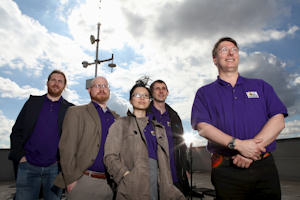Heads in the clouds – minds bright as sunlight
18 Dec 2014
How our Learning Through Research programme enhances their learning experience and improves their employability

Professor David Schultz has a vision. He wants his meteorology students to have the same Eureka! moments that inspired his own research.
ManUniCast – his innovative weather and air-quality forecasting model – means that’s now within their grasp.
Not only does the teaching tool enhance their critical thinking, it enables them to answer questions that would have been impossible previously. It also makes them markedly more employable when they graduate.
“I had to build it,” says Professor Schultz, who teaches a third-year meteorology course on the environmental science programme.
“I wanted to give my students access to meteorological model output because that’s how environmental predictions – meteorology, air quality, hydrology (flooding) or ecological modelling – are done in the modern world. They are all based around the same principle.
“Now, our students will now know how to use them.”
This is the perfect example of Learning Through Research, in which undergraduate students are taught about their subject by looking at – or even doing – research. This not only enhances our students’ learning experience, it will improve their employability by increasing the scope of their studies and skills base.
The concept of ManUniCast flourished after Professor Schultz won funding from the Higher Education Academy, and enthusiastic collaboration from expert academics Dr Jonathan Fairman and Dr Douglas Lowe.
When eLearning technologists Stuart Anderson, Elsa Lee and Reo Seo-Zindy came on board to design and develop a user-friendly web interface, it was finally brought into glorious life.
“ManUnicast is a high-quality research model, which means students can see real-time weather and air-quality forecasts every day,” says Professor Schultz.
“I call it our toy model, but it’s comparable to what the Met Office uses, and Manchester is the only place to have anything like it.
“Students will be leaving Manchester, getting jobs and using all kinds of ecological and climate models.
“If they have never had experience with these models before, they end up either trusting them too much or too little, whereas the truth actually lies somewhere in between.”
The output is freely available at ManUniCast, so even the general public has access to it online – prompting ‘hits’ from as far afield as Reading and New York.
Plans are in the pipeline to develop it as an iPhone app, and Professor Schultz has already introduced it at a European conference in Austria where educators gave it an excited welcome.
The learning tool also archives the data, which means students doing case studies can use the portal to refer to weather events in the past.
“They can choose a day they got stuck in a rainstorm at the beach and consult a past ManUniCast forecast to look at why that happened,” says Dr Fairman.
Dr Lowe highlights its ability to layer graphics so students can see the relationship between different variables.
“Students are doing their own research and writing it up, improving their critical thinking skills,” adds Professor Schultz.
“My research papers are inspired by weather that I’ve lived through and been curious about.
“I’m hoping to give the students the same kind of Eureka! moments I had, rather than being told: ‘Here’s your assignment go off and do it.’”
